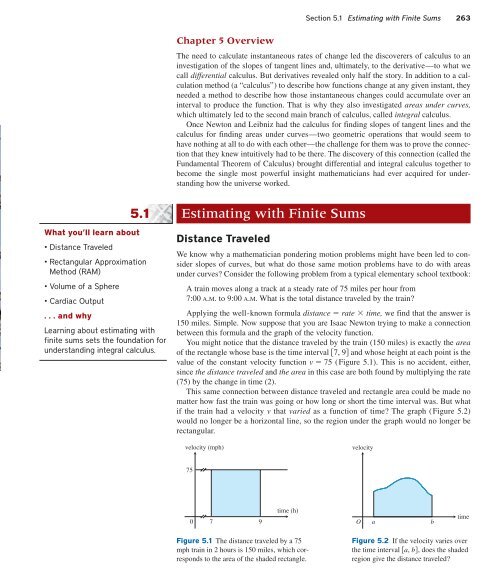FDWK_3ed_Ch05_pp262-319
FDWK_3ed_Ch05_pp262-319
FDWK_3ed_Ch05_pp262-319
Create successful ePaper yourself
Turn your PDF publications into a flip-book with our unique Google optimized e-Paper software.
Chapter 5 Overview<br />
Section 5.1 Estimating with Finite Sums 263<br />
The need to calculate instantaneous rates of change led the discoverers of calculus to an<br />
investigation of the slopes of tangent lines and, ultimately, to the derivative—to what we<br />
call differential calculus. But derivatives revealed only half the story. In addition to a calculation<br />
method (a “calculus”) to describe how functions change at any given instant, they<br />
needed a method to describe how those instantaneous changes could accumulate over an<br />
interval to produce the function. That is why they also investigated areas under curves,<br />
which ultimately led to the second main branch of calculus, called integral calculus.<br />
Once Newton and Leibniz had the calculus for finding slopes of tangent lines and the<br />
calculus for finding areas under curves—two geometric operations that would seem to<br />
have nothing at all to do with each other—the challenge for them was to prove the connection<br />
that they knew intuitively had to be there. The discovery of this connection (called the<br />
Fundamental Theorem of Calculus) brought differential and integral calculus together to<br />
become the single most powerful insight mathematicians had ever acquired for understanding<br />
how the universe worked.<br />
5.1<br />
What you’ll learn about<br />
• Distance Traveled<br />
• Rectangular Approximation<br />
Method (RAM)<br />
• Volume of a Sphere<br />
• Cardiac Output<br />
. . . and why<br />
Learning about estimating with<br />
finite sums sets the foundation for<br />
understanding integral calculus.<br />
Estimating with Finite Sums<br />
Distance Traveled<br />
We know why a mathematician pondering motion problems might have been led to consider<br />
slopes of curves, but what do those same motion problems have to do with areas<br />
under curves Consider the following problem from a typical elementary school textbook:<br />
A train moves along a track at a steady rate of 75 miles per hour from<br />
7:00 A.M. to 9:00 A.M. What is the total distance traveled by the train<br />
Applying the well-known formula distance rate time, we find that the answer is<br />
150 miles. Simple. Now suppose that you are Isaac Newton trying to make a connection<br />
between this formula and the graph of the velocity function.<br />
You might notice that the distance traveled by the train (150 miles) is exactly the area<br />
of the rectangle whose base is the time interval 7, 9 and whose height at each point is the<br />
value of the constant velocity function v 75 (Figure 5.1). This is no accident, either,<br />
since the distance traveled and the area in this case are both found by multiplying the rate<br />
(75) by the change in time (2).<br />
This same connection between distance traveled and rectangle area could be made no<br />
matter how fast the train was going or how long or short the time interval was. But what<br />
if the train had a velocity v that varied as a function of time The graph (Figure 5.2)<br />
would no longer be a horizontal line, so the region under the graph would no longer be<br />
rectangular.<br />
velocity (mph)<br />
velocity<br />
75<br />
0<br />
7 9<br />
time (h)<br />
O<br />
a<br />
b<br />
time<br />
Figure 5.1 The distance traveled by a 75<br />
mph train in 2 hours is 150 miles, which corresponds<br />
to the area of the shaded rectangle.<br />
Figure 5.2 If the velocity varies over<br />
the time interval a, b, does the shaded<br />
region give the distance traveled


